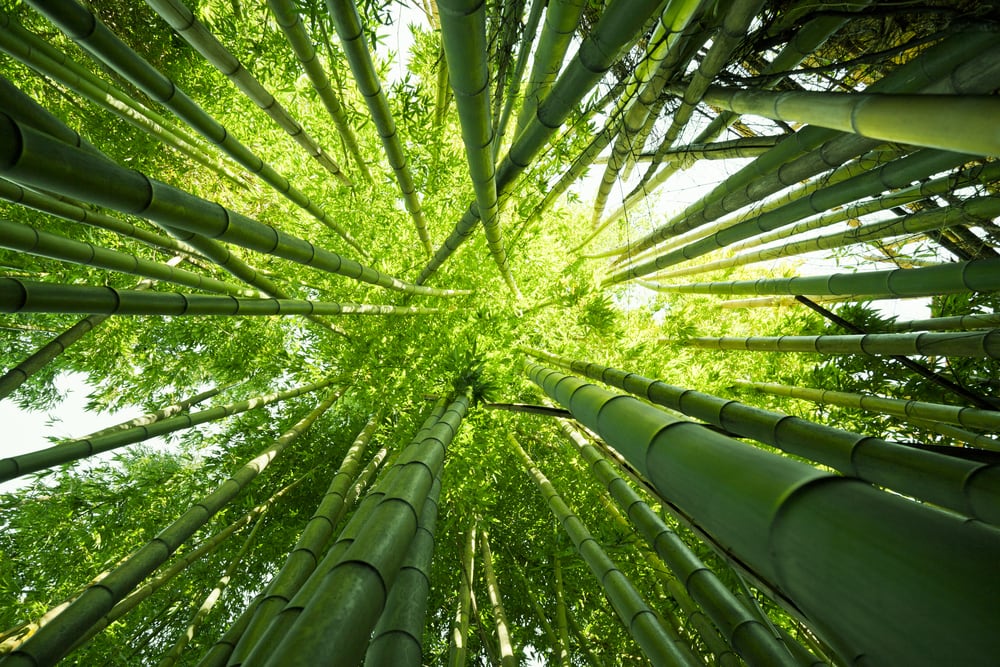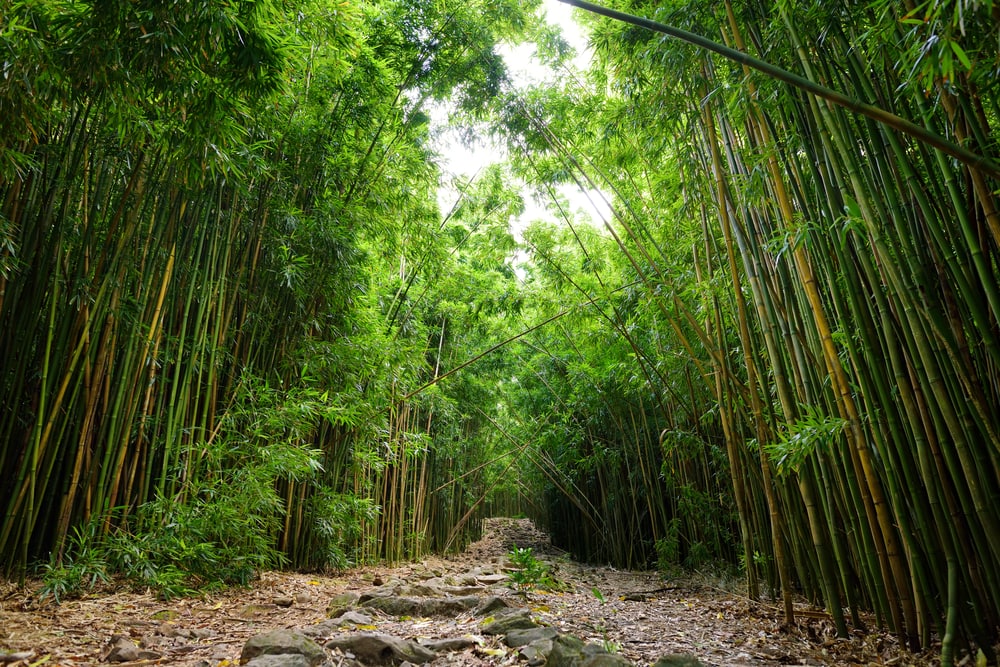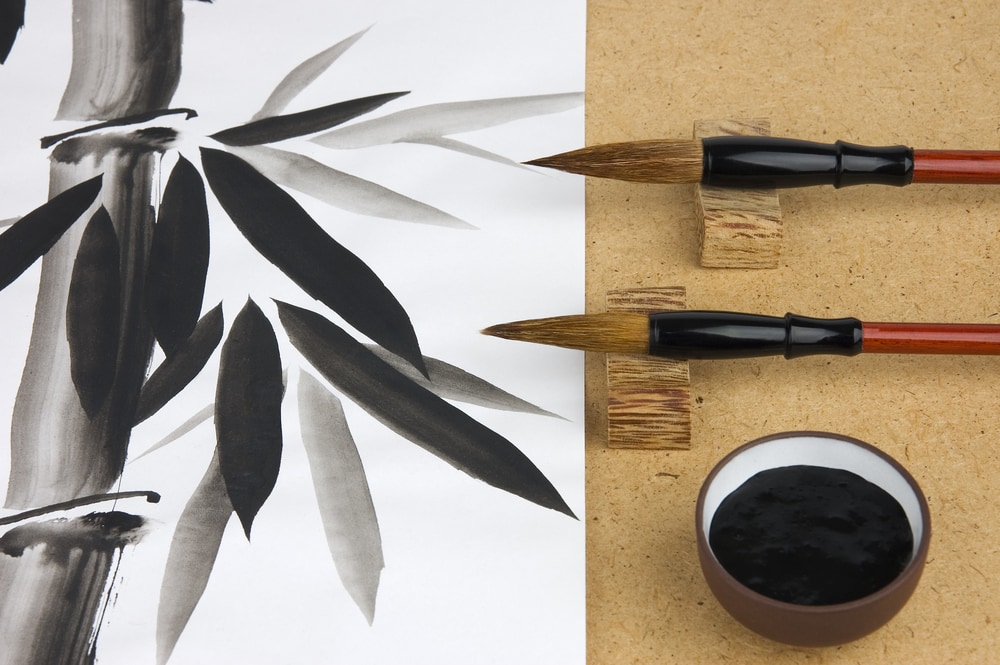Outforia Quicktake: Key Takeaways
- Bamboo holds the record as the fastest-growing plant on Earth, with some species growing up to one meter (2.91 ft) per day.
- Belonging to the Poaceae family, bamboo is a perennial evergreen in subtropical, tropical, and temperate climates, and they become herbaceous perennials in colder climates.
- A Chinese research team found that the fast growth of bamboo is likely due to a highly coordinated effort between cell wall biosynthesis, cell growth, and cell division.
- Bamboo species can be divided into two main types: running bamboo and clumping bamboo. The former spreads rapidly over a larger area, while the latter spreads more slowly, forming dense clumps.
- Bamboo has a fascinating life cycle. It remains in a vegetative phase for most of its life, flowers once, and then dies soon after. Bamboo also has the ability to cross-pollinate within close proximity.

In the realm of botanical wonders, bamboo reigns supreme as the fastest-growing plant on our planet.
Some species can surge skyward at a staggering rate of one meter (2.91 ft) per day, earning them a well-deserved Guinness World Record.
With more than 1,200 to 1,500 known species and new ones being found all the time, bamboo opens up a world of possibilities that have not been used yet. Join us as we explore bamboo’s speed, superpowers, and ecological promise.
What is Bamboo?

Bamboo belongs to the grass family of plants, the Poaceae. This is how bamboo is classified:
- Family: Poaceae
- Subfamily: Bambusoideae
- Tribe: Bambuseae
- Species: any of the 1450 species of bamboo.
Bamboo is a perennial evergreen in subtropical, tropical, and temperate climates. This means they live for a number of years and don’t lose their leaves in the winter.
In colder climates, they become herbaceous perennials. This means they die down in the winter and regrow from the roots once it gets warmer.
Bamboo has hollow stems. These have a scientific name: hollow internodal regions. That means the bit between the nodes, which are the little pieces that divide the bamboo stem into sections.
Where does bamboo come from?

You can find bamboo on most continents except Antarctica. It can even be found within the Arctic Circle.
The most obvious place of origin for bamboo is China, where it was first recorded and used as a crop. It can most commonly be found in Japan, South America, Southeast Asia, and the Southeast part of the United States.
It’s normally found in temperate, subtropical, and tropical areas. However, there are species of bamboo that can survive temperatures of minus 20°C in the winter.
For example, in Iowa, US. The top part of the plant dies in the cold, but the rhizomes survive.
Bamboo evolved from prehistoric grasses around 30 and 40 million years ago. That’s well after the time of the dinosaurs, but still a long time ago for us.
How to Identify Bamboo

A true bamboo will have these features:
- Hollow stems in the internodal regions
- No secondary growth wood (dicotyledonous woody xylem)
- Often clumps form (but not always)
- Rhizomes present under soil
- Rapid growth
- Columnar stem (in most species)
Two Types of Bamboo
There are two main types of bamboo. They spread in different ways.
Running Bamboo

Running bamboo produces long rhizomes. They colonize rapidly over a large area. These species include Phyllostachys, Arundinaria, Sasa, Psuedosasa, and Pleioblastus. These types of bamboo need a lot more space if they are planted in a garden.
A good way to control them is to put a barrier under the soil or put them in a sturdy container.
Yellow Groove Bamboo is an example running bamboo of the species Phyllostachys.
Clumping Bamboo

Clumping bamboo spreads more slowly. They form dense clumps. They can still spread vegetatively. Just not in the same aggressive way as running bamboo. Some clumping bamboos include Bambusa, Chusquia, Thamnocalamus, and Fargesia.
Andean bamboo is a Chusquia species that forms clumps.
Why Does Bamboo Grow So Fast?

Just how and why does bamboo grow so much faster than other plants?
A Chinese research team compared a slow-growing species of bamboo with a fast-growing species.
After looking at all the genes in the bamboo, they found that the slow bamboo had much lower levels of auxin. Auxin is a plant growth hormone. The slow bamboo also had irregular cell walls.
They concluded that a highly coordinated effort between cell wall biosynthesis, cell growth, and cell division was the likely reason behind the fast bamboo’s secret.

As bamboo shoots grow, they are fed nutrients by their connection to their parent plant. This connection is called a rhizome. It does the same job as an umbilical cord.
The young bamboo can grow fast, as it doesn’t need to produce leaves until it reaches its full height.
Bamboo also doesn’t waste energy making secondary growth wood. It stays the same diameter as it was when it was young. It doesn’t get wider and produce growth rings like a tree. This is why bamboo looks like a column and isn’t wide at the base like trees and shrubs.
You may also like: Perennial vs Annual Plants – Which Is Right for You?
The Life Cycle of Bamboo

Bamboo has a fascinating life cycle. Read on and never look at your windowsill lucky bamboo in the same way ever again.
1. Monocarpic Flowering

Bamboo does flower, but not for a long time. It stays in a vegetative phase for most of its life. It only flowers once, and then it dies soon after, usually within a year of flowering. This is known as being monocarpic.
The flowers themselves aren’t that showy. They are small and inconspicuous.
2. Synchronized Worldwide Flowering
Bamboo species around the world have amazing abilities. This is called gregarious flowering.
Every single member of that species of bamboo flowers at exactly the same time, regardless of how far apart they are from each other.
While this is a great example of synchronicity, it does have drawbacks. If there’s a drought or other climate event that affects the flowering, a whole species of bamboo can be wiped out.
3. Cross Pollination
Bamboo species in a small space can cross-pollinate. This means two different species can interbreed and create a new cultivar of bamboo.
4. Mass Seed Dispersal

So many seeds are released at once that there can be surges in the populations of species that eat bamboo seeds. This happened in India. Every member of one species of bamboo flowered and dropped seed at the same time.
This led to an explosion in the rat population, as they were eating all that lovely bamboo seed. Once the bamboo seed ran out, the hungry rats turned to crops. This caused a famine in parts of India.
5. Seed Germination
Once the seed is soaked in water for 24 hours, it starts to germinate. It needs to be kept warm and moist. Seed germination is not as easy as propagating bamboo from rhizomes and culms.
Culms are the hollow stems of bamboo. Germination happens in several weeks in most species.
6. Growing Up

A young bamboo culm will grow fast in the right conditions, with well-drained, moist soil that is slightly acidic. Depending on the species, it could be happier in part shade or in full sunlight.
Young plants don’t often need to have leaves until they have grown to their full height. This is because the parent bamboo has an “umbilical cord” in the form of a rhizome. This passes nutrients to the baby bamboo.
7. Maturity

Once the young bamboo culm has reached its full height, it sprouts leaves. Now it can photosynthesize. It is now independent from the parent as far as nutrition goes.
However, bamboo keeps it in the family. The now mature culm will begin to put out more rhizomes and baby culms using vegetative propagation.
This way, one bamboo plant can spread through an entire forest. All the plants can be clones of the parent plant. You could say bamboo is immortal, as even if the old culm dies, there are always new ones with the same genes.
You may also like: Types of Plants From the Dinosaur Age to the Present
How to Plant Bamboo in Your Garden

Thinking about getting a bamboo plant for your garden? Here are some tips on planting bamboo.
How to Plant Bamboo in a Container

You can keep bamboo indoors or outdoors in a container, too. Here’s how
- Choose a container that is sturdy enough to restrain the growth of the bamboo. Metal and wooden tubs are good. Wide containers allow the bamboo room to grow.
- Make sure there are drainage holes in the base. If there aren’t, drill some in. The soil must not get waterlogged.
- Position the pot where it will be protected from cold and drying winds. Inside is also good for smaller varieties. Choose a heavy pot that is low to the ground; otherwise, your tall bamboo may topple over.
- Use pot feet to raise the pot off the ground. Or bricks.
- Put a 5-7 cm (2–3 inch) layer of gravel in the bottom of the pot. This will aid drainage.
- Mix general-purpose compost with the same amount of slow-release fertilizer granules and water-retaining gel. Pots can dry out quickly. This should prevent your bamboo from drying out.
You may also like: Why Do Leaves Change Color In The Fall? The Science Of Autumn Colors
The Shunan Bamboo Sea
If you want to really immerse yourself in bamboo, why not visit the Shunan Bamboo Sea? This bamboo forest is the largest in the world, covering 27 mountains. It contains over 400 species of bamboo.
You can find it near Yibin City, south Sichuan, China.
Once inside the forest, you might spy Fishscale Bamboo (Phyllostachys heteroclada Oliver) and Purple Bamboo (P. nigra). The most dominant species is Nan bamboo (P. heterocycla).
Nan bamboo is very important to the local economy. The young shoots are very tasty, and the mature plants can be used for paper and handicrafts.
The forest is warm and wet, with an average temperature of 15.5 Celsius and lots of lovely rain. This makes it a good place for fungi and ferns to grow, too.
There are plenty of hiking trails. The Rainbow Waterfall and Qinglong Lake are among the many lovely places to visit.
Bamboo in Chinese Culture

Bamboo is deeply embedded in Chinese culture. Apart from food, clothing, transportation, and building, bamboo was also used for the first books. These books were constructed of thin strips of bamboo.
Most of the musical instruments in historical China were made of bamboo too.
You can listen to a bamboo flute being played here.
Bamboo is designated one of the “four gentlemen” in ancient Chinese culture.
The other three “gentlemen” plants are plum, orchid, and chrysanthemum. It is also known as one of the “three friends in winter,” the bamboo, pine, and plum.
The straight stem and clean outer surface of the bamboo represent honorability and chastity. The hollow stem represents humility.
Bamboo-inspired paintings by celebrated Chinese artists Zheng Banqiao (1693–1765) and Eastern Jin (317–420) calligrapher Wang Huizhi Poet Xue Tao of the Tang Dynasty chose to remain single for her whole life, taking bamboo as a symbolic companion.
You may also like: The 35 Different Types of Evergreen Trees: Images + Facts
Fun Facts About Bamboo

Check out these bamboozling facts about bamboo.
Bamboo FAQs

Why does bamboo turn yellow?
If bamboo turns yellow, it could be either overwatered or underwatered. It could also be deficient in nutrients.
If a bamboo turns completely yellow, it could be close to death. That said, if just a couple of stems or leaves are yellow, this is a normal process for bamboo.
How does bamboo reproduce?
Bamboo is a master of vegetative reproduction. This means it can reproduce by forming rhizomes under the soil and putting up more stems.
One bamboo plant is capable of generating a whole bamboo forest this way. All these plants would share the same genetic material. They are clones. Bamboo can also reproduce by seed, but it does not flower very often.
Can bamboo grow indoors?
There are plenty of bamboo species that you can grow indoors. You need to consider the full size of your species of bamboo.
Bamboo needs to be kept in a humid environment. It needs plenty of water with good drainage. They have varying needs as far as sunlight goes. It depends on the species.
What is the lifespan of bamboo?
Some woody bamboo used for construction can live for between 50 and 150 years.
Individual corms from garden bamboo varieties can live for a decade. New corms are always cloned to take their place. Lucky bamboo grown in water can live one to two years (more if it’s transferred to soil).
What colors does bamboo come in?
You can get species of bamboo with bright yellow-colored stalks and stalks that are black, bright green, or have vertical stripes of yellow and green. This last species is called painted bamboo for those reasons. It’s very pretty.








